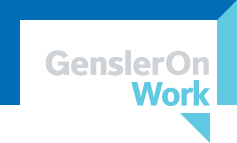The Smart and the Beautiful: Dichotomies in Workplace Design (Part Two)

DLA Piper Chicago. Photo: Steve Hall © Hall+Merrick.
Editor’s note: This is the second entry in a two-part series exploring how the design dichotomy of the smart and the beautiful plays out through the example of our Legal and Management Advisory clients. Read part one here.
The central challenge confronting Legal and Management Advisory firms today is one of continuous and transformational change. For these clients, a prime differentiator will be the degree to which an organization makes visceral its cultural promise, and how effective it is at framing its purpose and identity. Careful attention to a design’s physical form—the “beautiful” sequence of spaces and experiences—can profoundly elevate a workplace’s purpose and value, engaging the user on a deep, emotional level.
Beauty can be gauged as an emotional connection and a medium of transference between the subject of an experience and the designer’s intention for that experience. This transfer forges a deep connection, seizing one’s attention and launching sequences of engaged observation that build unique, intuitive, and even inspirational experiences. A comprehensive level of engagement goes beyond aesthetics, acting as a true differentiator and attaching to memory on a personal, powerful and positive level.
Following our post on the “smart” perspective to workplace design, this post will explore this cultural/experiential perspective, the beauty-driven side of the design dichotomy of the smart and the beautiful, the three drivers behind this perspective (collaboration, community, and differentiation), and the design imperatives that they inform (diversified choice, tailored experiences, and intentional wonder).
Diversified choice: greater collaboration requires choiceVisually diverse work settings not only engage and stimulate the senses. Studies show that collaboration can also help foster innovation. The Gensler Workplace Survey found that the most innovative lawyers spend 15 percent less time in a private office setting. Spending time in alternative work settings actually increases innovation. So how do you encourage it? Diversified choice in where and how to work—offering a range of focus and shared spaces, and mobility among them fosters balanced collaboration and increases opportunity for informal interactions and diverse stimuli.

For its new 10 Hudson Yards office, the Boston Consulting Group (BCG) wanted a radically different work environment for its highly mobile, independent, and diverse culture. Across six floors, a variety of tailored room types and flexible spaces provides a diversity of experiences and gives employees the autonomy to select how, when, and where they want to work. Image © Garret Rowland, Courtesy of Gensler.
Tailored experiences: community is created by engaged individualsCulture manifests itself through a company’s sense of inter-personal connection—its community. To build a binding team and client dynamic, the workplace culture must engage at a personal level. Borrowing from hospitality rather than corporate typologies can inform design that provides tailored experiences and drive higher levels of performance.

Taking a cue from hospitality, JLL’s Global Headquarters in Chicago features an internal hub—a social incubator of the JLL “membership” culture. The Club’s informal, whimsical design has become the center for client engagement and social network outreach, engendering affection from staff, colleagues, and clients alike. Photo: Steve Hall ©, Hedrich Blessing | Courtesy of JLL/Gensler.
Intentional wonder: differentiation requires a deep, visceral emotional connectionToday’s highly competitive marketplace makes the workplace a differentiator. And it differentiates on the experience it delivers. This creates the imperative for the ‘wow’ moment: design elements that evoke an emotional connection through intentional wonder to communicate an organization’s purpose and aspirational identity. When workplace design creates that connection it engages clients and the community at large.
These moments are clearly expressed through dramatic volumes, as in the case of CBRE’s Los Angles offices in a renovated masonic temple. The collaborative “heart” of the workplace is a two-story central space that visually connects the entire office. Similarly, Boston Consulting Group’s Hudson Yards design features a six-story stairwell with divergent stair directions that animate the space and stitch together vertically distributed and diverse workspaces.

The collaborative heart of CBRE’s Los Angeles North space takes advantage of the dramatic two-story central area to visually connect the entire office. Photo: Ryan Gobuty, Courtesy of Gensler.
Through various design strategies, each of these examples achieve deep, visceral connections between the participant and the space; communicating an organization’s highest aspirational objectives through form, texture, light, volume, and the sequence of experience.
Organizations that leverage both “smart” (focusing on what drives effectiveness) and “beautiful” (focusing on what frames identity) perspectives to their workplace designs consistently optimize the potential of continuous, and transformational change.It is through this symbiotic relationship that intelligent workplaces emerge delivering both practical and inspirational designs through the confluence of the smart and the beautiful.
To further engage in this subject, learn more about our Legal and Management Advisory practices.
 |
Jim Prendergast, FAIA IIDA, is a Design Principal and Global Management Advisory Industry Expert based in Gensler’s Chicago office. Jim specializes in innovative and refined workplace designs. Over the last 30 years Jim has designed nearly 10 million square feet of commercial interiors. An innovative award-winning designer and progressive thinker, Jim is frequently invited to present his work at client professional forums and lecture as part of university curriculums on design and its impact on client culture and performance. Jim’s work is frequently featured in premier design publications. He has received multiple design awards, as well as AIA-Chicago's Young Architect Award, and is a member of the AIA's College of Fellows. Contact him at jim_prendergast@gensler.com. |

 Jim Prendergast
Jim Prendergast